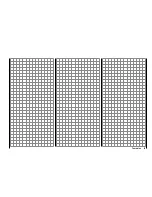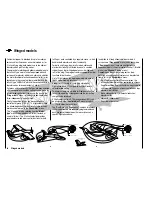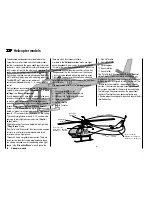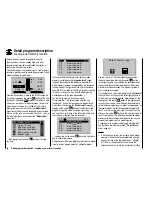
47
Installation notices
Receiver system power supply
Among other aspects, the safe operation of a model
depends on a reliable power supply. In the event that,
despite smooth operating rods, fully charged battery,
battery leads with adequate cross-section, minimum
contact resistances at connectors, etc., the transmitter
indicates repeated receiver voltage collapses or is
receiver voltage is generally too low; please give
attention to the following notices.
Give primary attention to fully charged batteries when
model operation is to be started. Be sure that the
contact surfaces of connectors and switches really are
low resistance. If necessary, measure the voltage drop
across installed switch cables when they are under
load because even new heavy-duty switches can cause
a voltage drop of up to 0.2 V. This value can increase
in contacts by factors as a consequence of aging and
oxidation. The constant vibrations and jarring also takes
its toll on contacts to produce a creeping increase of
contact resistance.
Servos present another possible problem source. Even
rather small servos like a
Graupner/JR
DS-281 can draw
up to 0.75 A of current when it is blocks under load. Just
four of these servos in a "foam" model can therefore load
down the on-board power supply by as much as 3 A …
Therefore you should choose a power supply which will
not break down under greater loads but rather always
deliver suffi cient voltage. To "calculate" necessary
battery capacity you should always fi gure on at least
350 mAh for every analog servo and at least 500 mAh
for every digital servo.
For example, from this point of view a battery with
1400 mAh would be the absolute minimum to power
a receiver system with a total of 4 analog servos. But
be sure to also consider the receiver itself into the
calculation because its bidirectional functionality will
draw about 70 mA of current too.
It is also a good practice to connect the receiver to
its power source with two cables rather than just one.
Cable "1" could be connected to the "12+B" receiver
connector as is usual and cable "2" could be connected
to the opposite end of the row at the connector labeled
"11+B". For example by using two power supply cables
to connect one switch or voltage regulator to the
receiver. Just use a V or Y cable, Order No.
3936.11
to accomplish this (see fi gure) if you should need one
or both of the receiver's connectors to attach a servo,
speed controller, etc. This double-connection technique
to switches and speed controllers not only reduces the
risk of a cable break but also ensures a more uniform
supply of power to the connected servo.
Aux. function
Y-lead
Order No.
3936.11
PRX stabilised
receiver power supply
Order No.
4136
NiMH 4-cell battery packs
In compliance with the aforementioned conditions, your
Graupner
HoTT receiver system can be readily operated
with traditional 4-cell battery packs as long as the packs
have adequate capacity and voltage level.
NiMH 5-cell battery packs
Five-cell battery packs offer a greater voltage tolerance
than do 4-cell packs.
However, be aware that not every servo available on
the market is able to tolerate the voltage level output by
a 5-cell pack over the long term, this is particularly true
when the battery pack is freshly charged. Some of these
servos react to this with a noticeable "grinding" sound.
Therefore pay attention to the specifi cations of the
servos you use before making a choice for a 5-cell
battery pack..
LiFe 6.6 V batteries with 2 cells
From a contemporary perspective, these new cells are
the very best choice.
LiFe cells are also available in hard plastic casings to
protect them from mechanical damage. Like LiPo cells,
LiFe cells can be quick charged in suitable chargers and
they are comparatively robust.
This type of secondary cell battery is also rated for a
signifi cantly greater number of charge/discharge cycles
than, for example, LiPo batteries The nominal 6.6 V
output of a 2-cell LiFe battery pack does not present
a problem for either
Graupner
HoTT receivers nor for
those servos, speed controllers, gyros and other devices
which have been specifi cally approved for operation in
this – higher – voltage range.
Please note however
that practically all servos, speed controllers, gyros
and other devices built in the past and most such
devices currently still offered on the market have
only a permissible voltage range of 4.8 to 6 V.
Use
of these batteries in conjunction with these devices
demand use of a stabilized voltage regulator, e. g. the
PRX, Order No.
4136
, see appendix. Otherwise there is
danger that attached devices will incur damage within a
short period of time.
LiPo 2-cell packs
For a given capacity, LiPo batteries are lighter than,
Summary of Contents for mx-20 Hott
Page 41: ...41 Your notes...
Page 49: ...49 Your notes...
Page 55: ...55 Your notes...
Page 81: ...81 Your notes...
Page 85: ...85 Your notes...
Page 89: ...89 Your notes...
Page 99: ...99 Detail program description Control adjust...
Page 127: ...127 Detail program description Control adjust...
Page 131: ...131 Detail program description Control adjust...
Page 163: ...163 Detail program description Control adjust...
Page 191: ...191 Detail program description Control adjust...
Page 207: ...207 Detail program description Control adjust...
Page 228: ...228 Detail program description Control adjust...
Page 229: ...229 Detail program description Control adjust...
Page 251: ...251 Detail program description Control adjust...
















































